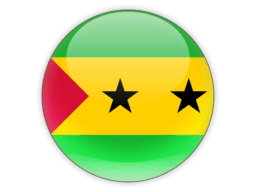
Regions of Sao Tome and Principe
Explore 2 regions
Cities of Sao Tome and Principe
Discover 5 cities across 2 regions
Príncipe(1)
São Tomé Island(4)
Sao Tome and Principe is a small island nation located in the Gulf of Guinea, off the coast of West Africa. The country consists of two main islands, Sao Tome and Principe, and several smaller islets. The capital city is Sao Tome.
Sao Tome and Principe was a Portuguese colony until it gained independence in 1975. Since then, the country has struggled with political instability, corruption, and poverty. However, in recent years, there have been some improvements in governance and economic growth.
The population of Sao Tome and Principe is estimated to be around 219,000, with most of the people living on the island of Sao Tome. The official language is Portuguese, but many people also speak Forro, a Creole language that developed from Portuguese.
The economy of Sao Tome and Principe is heavily reliant on agriculture, with cocoa and coffee being the main export crops. Fishing and tourism are also important sources of income for the country. The country has few natural resources, and infrastructure is limited, which has hindered economic development.
Sao Tome and Principe is known for its natural beauty and biodiversity, with lush rainforests, pristine beaches, and diverse wildlife. The country has several protected areas, including the Obo National Park and the Pico Cao Grande Natural Monument, which are home to many endemic species.
Telephone Code
239
Local Emergency Phone
2-22-22-22; Fire: 112
Vaccinations
Proof of yellow fever vaccination is required to enter Sao Tome and Príncipe if traveling from a region with yellow fever. See WHO recommendations.
Climate
tropical; hot, humid; rainy season October to May
Currency (Code)
Sao Tome and Príncipe dobra (STN)
Electricity/Voltage/Plug Type(s)
220 V / 50 Hz / plug types(s): C,F
Major Languages
Portuguese 98.4% (official), Forro 36.2%, Cabo Verdian 8.5%, French 6.8%, Angolar 6.6%, English 4.9%, other Portuguese-based Creoles are also spoken
Major Religions
Catholic 55.7%, Adventist 4.1%, Assembly of God 3.4%, other 6.2%, none 21.2%
Potable Water
Opt for bottled water
International Driving Permit
Required
Road Driving Side
Right
Tourist Destinations
Obo National Park; Pico de Sao Tome; Rolas Island; Boca de Inferno; Jale Beach; Principe Ecological Zone
Major Sports
Soccer
Cultural Practices
Manners and etiquette are considered important; greeting a person and inquiring about his or her health and family is essential in social encounters. Older people tend to be treated with great respect, particularly if they have many children and grandchildren. Entry into a person's home or garden is a privilege; acquaintances often converse in the road or across a garden hedge rather than enter a house or yard.
Tipping Guidelines
Tipping in Sao Tome and Principe is part of the culture. While it is normal to tip the different service providers, if the service you are receiving is not good, you may decide to give a tip lower than what is stated as the normal tipping amount or decide not to give any tip at all; average tipping percentage in restaurants is between 7% to 13%, between 8% to 20% for taxi drivers, and between 2.00 to 5.00 USD/EURO/GBP in hotels.
Souvenirs
Carved wooden masks and other tribal items, stamps, tortoise-shell jewelry and decorative items
Traditional Cuisine
Calulu de peixe (Fish calulu) — a smoked fish stew which combines various vegetables cooked in red palm oil with okra and sweet potato leaves; traditionally accompanied by rice or funje (a creamy cassava porridge)
Geography
Area
total: 964 sq km
land: 964 sq km
water: 0 sq km
Climate
tropical; hot, humid; one rainy season (October to May)
Natural resources
fish, hydropower
People and Society
Population
220,372 (2023 est.)
Ethnic groups
Mestico, Angolares (descendants of Angolan slaves), Forros (descendants of freed slaves), Servicais (contract laborers from Angola, Mozambique, and Cabo Verde), Tongas (children of servicais born on the islands), Europeans (primarily Portuguese), Asians (mostly Chinese)
Languages
Portuguese 98.4% (official), Forro 36.2%, Cabo Verdian 8.5%, French 6.8%, Angolar 6.6%, English 4.9%, Lunguie 1%, other (including sign language) 2.4%; note - shares sum to more than 100% because some respondents gave more than one answer on the census; other Portuguese-based Creoles are also spoken (2012 est.)
Religions
Catholic 55.7%, Adventist 4.1%, Assembly of God 3.4%, New Apostolic 2.9%, Mana 2.3%, Universal Kingdom of God 2%, Jehovah's Witness 1.2%, other 6.2%, none 21.2%, unspecified 1% (2012 est.)
Population growth rate
1.45% (2023 est.)
Government
Government type
semi-presidential republic
Capital
name: Sao Tome
Economy
Economic overview
ower middle-income Central African island economy; falling cocoa production due to drought and mismanagement; joint oil venture with Nigeria; government owns 90% of land; high debt, partly from fuel subsidies; tourism gutted by COVID-19
Real GDP (purchasing power parity)
$904.057 million (2021 est.)
Real GDP per capita
$4,100 (2021 est.)
Agricultural products
plantains, oil palm fruit, coconuts, taro, bananas, fruit, cocoa, yams, cassava, maize
Industries
light construction, textiles, soap, beer, fish processing, timber
Exports
$75.256 million (2021 est.)
Exports - partners
Singapore 30%, Switzerland 24%, France 11%, Poland 7%, Belgium 7%, United States 5% (2019)
Exports - commodities
gas turbines, cocoa beans, aircraft parts, iron products, chocolate (2019)
Imports
$201.145 million (2021 est.)
Imports - partners
Portugal 41%, Angola 17%, China 8% (2019 )
Imports - commodities
refined petroleum, cars, rice, flavored water, postage stamps (2019)
International Airports in Sao Tome and Principe
Discover 2 major airports serving Sao Tome and Principe
Mark Sao Tome and Principe as Visited
Add Sao Tome and Principe to your personal travel map and track your journey around the world. Share your adventures and see your progress grow!